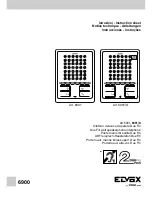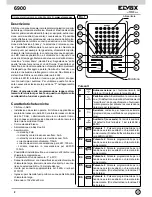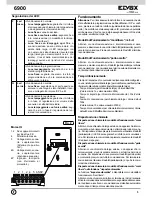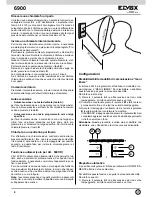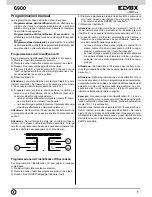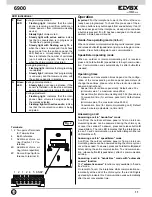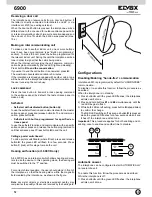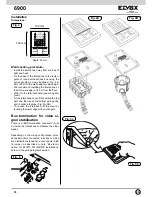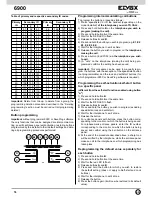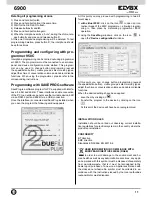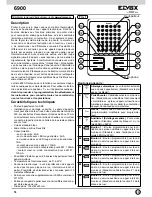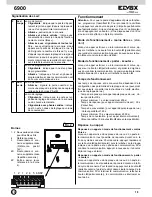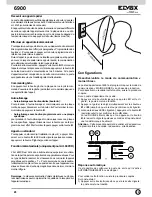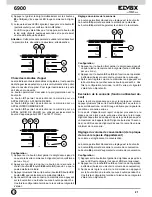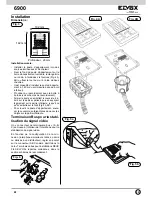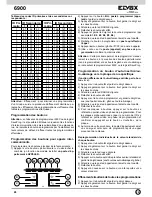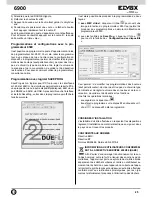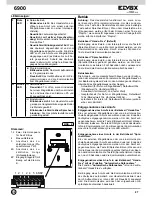
12
6900
EN
Receiving a door call
The interphone can receive calls from a door call button, if
the latter is directly connected to terminals 4 and 6P or via
interface art. 6120 (see wiring versions).
When the door call button is pressed, the interphone emits a
different tone to the one used for outdoor entrance panel calls
or intercommunicating calls; chime cycle duration depends on
the amount of time for which the button was pressed (max.
10 s).
Making an intercommunicating call
To make a call to another indoor unit, one or more buttons
must have been programmed (see “Button programming”
section). To make the call, press the button programmed for
the relevant indoor unit. During the call, the interphone emits a
tone in order to signal that the call is being made.
When the internal unit receiving the call answers, communi-
cation begins automatically (the red LED lights up steadily).
Press button
B to end the conversation.
If you want to end the call before it is answered, press
B
.
The maximum conversation duration is 5 minutes.
If the interphone is already engaged with another call, a tone
will be heard on the interphone making the call to indicate that
the user receiving the call is busy.
Lock command
Press the lock button to transmit a lock opening command
to the entrance panel (by default, the last entrance panel to
make a call).
Self-start
- Self-start with dedicated button (button A):
to use the self-start function and communicate with the master
entrance panel, press and release button
A
. To end communi-
cation, press button
B
.
- Self-start with button programmed for specified en
-
trance panel
:
to use the self-start function and communicate with a specific
entrance panel, press and release the button programmed to
call that entrance panel. Press button
B
to end the call.
Calling a porter switchboard
To call a porter switchboard (where fitted): press and release
button
B
; the green LED will flash for a few seconds. Press
button
C
(lock) at this stage to make the call.
Hearing aid function (art. 6901/D only)
Art. 6901/D has an internal coil which allows hearing aid wea-
rers to use the device. In this operating mode, the hearing aid
must be switched to the “T” position.
For correct chime reception, the user should stand in front of
the interphone, so that the hearing aid is within the magnetic
field created by the interphone, as shown in the figure.
Note
: any metal objects or electronic equipment nearby may
compromise the quality of the sound received by the hearing aid.
Configurations
Disabling/Enabling “hands-free” communication
Interphone 6901 is programmed by default for “HANDS-FREE”
communication.
To disable or re-enable this function, follow the procedure as
described.
When the interphone is in standby:
1) Press button
A
until the green LED flashes; the interphone
will also emit a tone.
2) Press and hold buttons
E1
and
E2
simultaneously, until the
red LED begins to flash.
3) While both LEDs are flashing, press button
B
(speak/listen)
to confirm the change.
The RED LED switches off as soon as button
B
is pressed,
while the green LED flashes for a few seconds when it swi
-
tches off, the interphone emits a tone.
Important
: This procedure applies for both enabling and di-
sabling, once to enable and another time to disable.
A
B
E2
E1
Automatic answer
The interphone can be configured to start AUTOMATICALLY
on receipt of a call.
To enable this function, follow the procedure as described.
While the interphone is off:
1) Press button
A
until the green LED flashes; the interphone
will also emit a tone.
30÷40 cm
30÷40 cm

